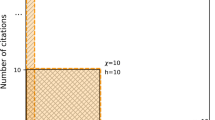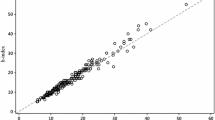Abstract
A family of measures of a journal’s impact is considered that takes account of the dispersion, as well as the mean, of the number of citations in a journal. These measures, called the Mean Dispersion Indices (MDI), generalize the stabilized-JIF recently introduced by Lando and Bertoli-Barsotti (J Informetr 11(3):689–703, 2017). The MDI use a geometric weighted average of the number of citations and the Gini coefficient to measure the dispersion of the number of citations. Journal rankings based on these measures are compared with those obtained from the Journal Impact Factor, the Scimago Journal Rank, the h-index measure, and the Eigenfactor rankings, four of the most well-known current impact measures. This comparison suggests that the different rankings may implicitly place different weights on dispersion and the average number of citations and some appear to show little correlation with dispersion.

Similar content being viewed by others
Notes
The Source Normalized Impact per Paper (SNIP) is a widely used index not included in this paper. It is calculated by dividing the mean number of citations in a 3-year period by a scalar that is determined based on the subject area. It allows comparing journals across disciplines. This would suggest that within disciplines SNIP rankings will not vary much from the rankings produced by the JIF when applied to the same citation database. Since this paper is focused within the Economics discipline, SNIP is not included in the comparisons.
These exceptions were mainly found in computer science related fields since many of the prominent publications are conference proceedings. Since this paper uses economics journals, these differences should not affect the analysis.
Formerly Thomson Reuters Web of Science.
The h-index included in this report uses a 5 years time window (see Table 7).
For example, if your list of journal citations were (1, 10, 100), the Gini coefficient would be equal to \(\frac{{\left| {1 - 10} \right| + \left| {1 - 100} \right| + \left| {10 - 1} \right| + \left| {10 - 100} \right| + \left| {100 - 1} \right| + \left| {100 - 10} \right|}}{{2*3*\left( {1 + 10 + 100} \right)}} = 0.595\).
References
Bar-Ilan, J. (2008). Which h-index? A comparison of WoS, Scopus and Google Scholar. Scientometrics, 74(2), 257–271.
Bergstrom, C. (2007). Eigenfactor: Measuring the value and prestige of scholarly journals. College & Research Libraries News, 68(5), 314–316.
Garfeld, E., & Sher, I. H. (1963). New factors in the evaluation of scientific literature through citation indexing. Journal of the Association for Information Science and Technology, 14(3), 195–201.
Garfield, E. (1955). Citation indexes for science: A new dimension in documentation through association of ideas. Science, 122, 108–111.
Garfield, E. (1972). Citation analysis as a tool in journal evaluation. Science, 178, 471–479.
Garfield, E. (1998). Long-term vs. short-term journal impact: Does it matter. Scientist, 12(3), 11–12.
Garfield, E. (2006). The history and meaning of the journal impact factor. Journal of the American Medical Association, 295(1), 90–93.
Glötzl, F., & Aigner, E. (2017). Six dimensions of concentration in economics: Scientometric evidence from a large-scale data set. Ecological Economics Papers, 15, WU Vienna University of Economics and Business, Vienna. Institute of Ecological Economics.
González-Pereira, B., Guerrero-Bote, V. P., & Moya- Anegón, F. (2010). A new approach to the metric of journals’ scientific prestige: The SJR Indicator. Journal of Informetrics, 4(3), 379–391.
Harzing, A. W. (2013). A preliminary test of Google Scholar as a source for citation data: A longitudinal study of Nobel Prize winners. Scientometrics, 94(3), 1057–1075.
Harzing, A. W., & Van Der Wal, R. (2008). Comparing the Google Scholar h-index with the ISI journal impact factor. Reserach in International Management Products and Services for Academics.
Harzing, A. W., & Van Der Wal, R. (2009). A Google Scholar h-index for journals: An alternative metric to measure journal impact in economics and business. Journal of the Association for Information Science and Technology, 60(1), 41–46.
Hirsch, J. E. (2005). An index to quantity an individual’s scientific research output. Proceedings of the National Academy of Science, 102(46), 16569–16572.
Lando, T., & Bertoli-Barsotti, L. (2017). Measuring the citation impact of journals with generalized Lorenz curves. Journal of Informetrics, 11(3), 689–703.
Leydesdorff, L. (2008). Caveats for the use of citation indicators in research and journal evaluations. Journal of the Association for Information Science and Technology, 59(2), 278–287.
Leydesdorff, L. (2009). How are new citation-based journal indicators adding to the bibliometric toolbox? Journal of the Association for Information Science and Technology, 60(7), 1327–1336.
Moed, H. F. (2010). Measuring contextual citation impact of scientific journals. Journal of Informetrics, 4(3), 265–277.
Stern, D. I. (2013). Uncertainty measures for economics journal impact factors. Journal of Economic Literature, 51, 173–189.
Thelwall, M. (2016). Not dead, just resting: The practical value of per publication citation indicators. arXiv preprint arXiv:1606.00193.
Waltman, L. (2016). A review of the literature on citation impact indicators. Journal of Informetrics, 10(2), 365–391.
Acknowledgements
The authors appreciate the helpful and supportive comments provided by the editor and referees.
Author information
Authors and Affiliations
Corresponding author
Appendix
Appendix
Table of All 56 Journals with Mean and Gini Coefficient for the 2 years period leading up to 2014.
Journal | Mean | Gini coefficient | |
|---|---|---|---|
1 | American Economic Review | 3.7618 | 0.6002 |
2 | American Journal of Agricultural Economics | 1.2038 | 0.6966 |
3 | Annual Review of Economics | 2.9762 | 0.5731 |
4 | Brookings Papers On Economic Activity | 3.0833 | 0.6903 |
5 | Cambridge Journal of Economics | 1.5037 | 0.6310 |
6 | Ecological Economics | 2.7991 | 0.5702 |
7 | Econometrica | 4.0347 | 0.4906 |
8 | Economic Development and Cultural Change | 1.3774 | 0.5795 |
9 | Economic Geography | 2.0645 | 0.5796 |
10 | Economic Journal | 2.0863 | 0.5112 |
11 | Economic Policy | 2.6364 | 0.5670 |
12 | Economic Systems Research | 3.3333 | 0.7279 |
13 | Economy and Society | 1.6364 | 0.6521 |
14 | Emerging Markets Review | 1.4815 | 0.5259 |
15 | Energy Economics | 2.9622 | 0.5717 |
16 | Energy Journal | 1.6282 | 0.6640 |
17 | European Journal of Political Economy | 1.5229 | 0.5942 |
18 | European Review of Agricultural Economics | 1.1143 | 0.6070 |
19 | Food Policy | 1.8022 | 0.5845 |
20 | Journal of Agricultural Economics | 1.2278 | 0.6454 |
21 | Journal of Applied Econometrics | 1.5636 | 0.6738 |
22 | Journal of Econometrics | 1.7769 | 0.5571 |
23 | Journal of Economic Geography | 2.5227 | 0.5839 |
24 | Journal of Economic Growth | 3.5417 | 0.6123 |
25 | Journal of Economic History | 1.4355 | 0.6029 |
26 | Journal of Economic Literature | 6.2927 | 0.5576 |
27 | Journal of Economic Perspectives | 5.5517 | 0.5461 |
28 | Journal of Economic Surveys | 2.2105 | 0.5500 |
29 | Journal of Environmental Economics and Management | 2.6984 | 0.5965 |
30 | Journal of Finance | 5.4961 | 0.4606 |
31 | Journal of Financial and Quantitative Analysis | 1.5310 | 0.6177 |
32 | Journal of Financial Econometrics | 1.2326 | 0.6222 |
33 | Journal of Financial Economics | 4.1661 | 0.5606 |
34 | Journal of Human Resources | 1.4928 | 0.5499 |
35 | Journal of International Economics | 2.6865 | 0.6027 |
36 | Journal of Labor Economics | 2.0357 | 0.5132 |
37 | Journal of Monetary Economics | 1.7297 | 0.5811 |
38 | Journal of Political Economy | 3.6271 | 0.4754 |
39 | Journal of Public Economics | 1.6162 | 0.6108 |
40 | Journal of Urban Economics | 1.6848 | 0.5524 |
41 | Land Economics | 1.4125 | 0.7006 |
42 | Marine Resource Economics | 1.8571 | 0.6398 |
43 | Mathematical Finance | 1.1290 | 0.6171 |
44 | Oxford Bulletin of Economics and Statistics | 1.3218 | 0.6435 |
45 | Quantitative Economics | 1.7667 | 0.4849 |
46 | Quarterly Journal of Economics | 7.2346 | 0.5582 |
47 | Rand Journal of Economics | 1.3594 | 0.6302 |
48 | Review of Economic Dynamics | 1.4110 | 0.6472 |
49 | Review of Economic Studies | 4.1827 | 0.5376 |
50 | Review of Economics and Statistics | 2.7487 | 0.5600 |
51 | Review of Environmental Economics and Policy | 3.5161 | 0.4782 |
52 | Review of Financial Studies | 3.0955 | 0.5217 |
53 | Review of International Political Economy | 1.7867 | 0.6714 |
54 | Small Business Economics | 1.8995 | 0.5950 |
55 | World Bank Economic Review | 1.3721 | 0.6985 |
56 | World Development | 2.0701 | 0.5883 |
Rights and permissions
About this article
Cite this article
Cockriel, W.M., McDonald, J.B. The influence of dispersion on journal impact measures. Scientometrics 116, 609–622 (2018). https://doi.org/10.1007/s11192-018-2755-1
Received:
Published:
Issue Date:
DOI: https://doi.org/10.1007/s11192-018-2755-1




